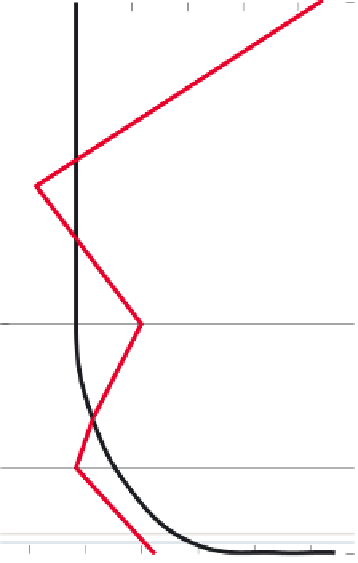Environmental Engineering Reference
In-Depth Information
ganisms and materials (such as metals and stone used
in buildings and statues) and to alter climate. The ef-
fects of air pollution range from annoying to lethal.
Air pollutants come from both natural and human
sources. Natural sources include dust blowing off the
earth's surface (Figure 5-1, p. 78), forest fires, volcanic
eruptions volatile organic chemicals released by some
plants, the decay of plants, and sea spray. Most natural
sources of air pollution are spread out and, except for
those from volcanic eruptions and some forest fires,
rarely reach harmful levels.
Air pollution from human activities is not new
(Science Spotlight, p. 350). Since our discovery of fire,
we have added various types of pollutants to the tropo-
sphere. Our inputs increased when we began extract-
ing and burning coal, first for heat and later for gener-
ating electricity and producing materials such as steel.
Most outdoor pollutants from human activities in
today's urban areas enter the atmosphere from the
burning of fossil fuels in power plants and factories
(
stationary sources,
Figure 1-8, p. 12) and in motor vehi-
cles (
mobile sources
). Pollutants from such activities can
reach harmful levels in the troposphere, especially in
urban areas where people, cars, and industrial activi-
ties are concentrated.
Scientists classify outdoor air pollutants into two
categories.
Primary pollutants
are emitted directly
into the troposphere in a potentially harmful form. Ex-
amples include soot and carbon monoxide. While in
the troposphere, some primary pollutants may react
with one another or with the basic components of air
to form new pollutants, called
secondary pollutants
(Figure 15-3, p. 348).
Because of their high concentrations of cars and
factories, cities normally have higher air pollution lev-
els than rural areas. However, prevailing winds can
spread long-lived primary and secondary air pollu-
tants from urban and industrial areas to the country-
side as well as to other urban areas.
Indoor air pollutants come from infiltration of
polluted outdoor air and chemicals used or produced
inside buildings. Experts in risk analysis rate indoor
and outdoor air pollution as high-risk human health
problems.
According to the World Health Organization
(WHO), one of every six people on the earth (more
than 1.1 billion people) lives in an urban area where
the outdoor air is unhealthy to breathe. Most of these
individuals live in densely populated cities in devel-
oping countries where air pollution control laws do
not exist or are poorly enforced. The biggest health
threat comes from indoor air pollution when the poor
must burn wood, charcoal, coal, or dung in open fires
or poorly designed stoves to heat their dwellings and
cook their food. In other words, poverty can mean
poor air for poor people.
Atmospheric pressure (millibars)
0
200
400
600
800
1,000
120
75
Temperature
Pressure
110
65
Thermosphere
100
90
55
Mesopause
Heating via ozone
80
45
Mesosphere
70
60
Stratopause
35
50
Stratosphere
40
25
30
Tropopause
15
Ozone “layer”
Heating from the earth
20
Troposphere
10
5
Pressure =
1,000
millibars at
ground level
0
(Sea
level)
-80
-40
0
40
80
120
Temperature (˚C)
Figure 15-2
Natural capital:
the earth's atmosphere consists
of several layers. The average temperature of the atmosphere
varies with altitude (red line). Most UV radiation from the sun is
absorbed by ozone (O
3
), found primarily in the stratosphere in
the
ozone layer
17-26 kilometers (10-16 miles) above sea
level.
also prevents much of the oxygen in the troposphere
from being converted to photochemical ozone, a harm-
ful air pollutant.
Some human activities are
decreasing
the amount of
beneficial or “good” ozone in the stratosphere and
in-
creasing
the amount of harmful or “bad” ozone in the
troposphere—especially in some urban areas. Ozone in
this portion of the atmosphere near the earth's surface
damages plants, lung tissues, and some materials such
as rubber.
15-2
OUTDOOR AIR POLLUTION
Science: Types and Sources
of Air Pollution
Outdoor air pollutants come mostly from natural
sources and burning fossil fuels in motor vehicles and
power and industrial plants.
Air pollution
is the presence of chemicals in the at-
mosphere in concentrations high enough to harm or-



























